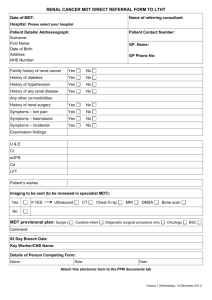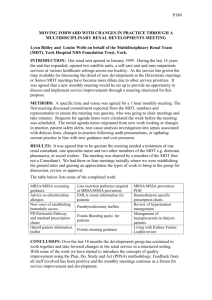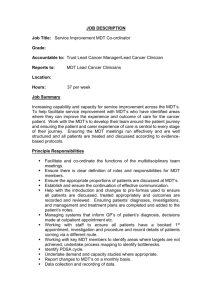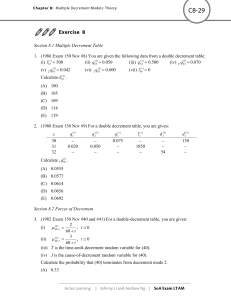Multiple decrements tables with lifecontingencies packages
advertisement
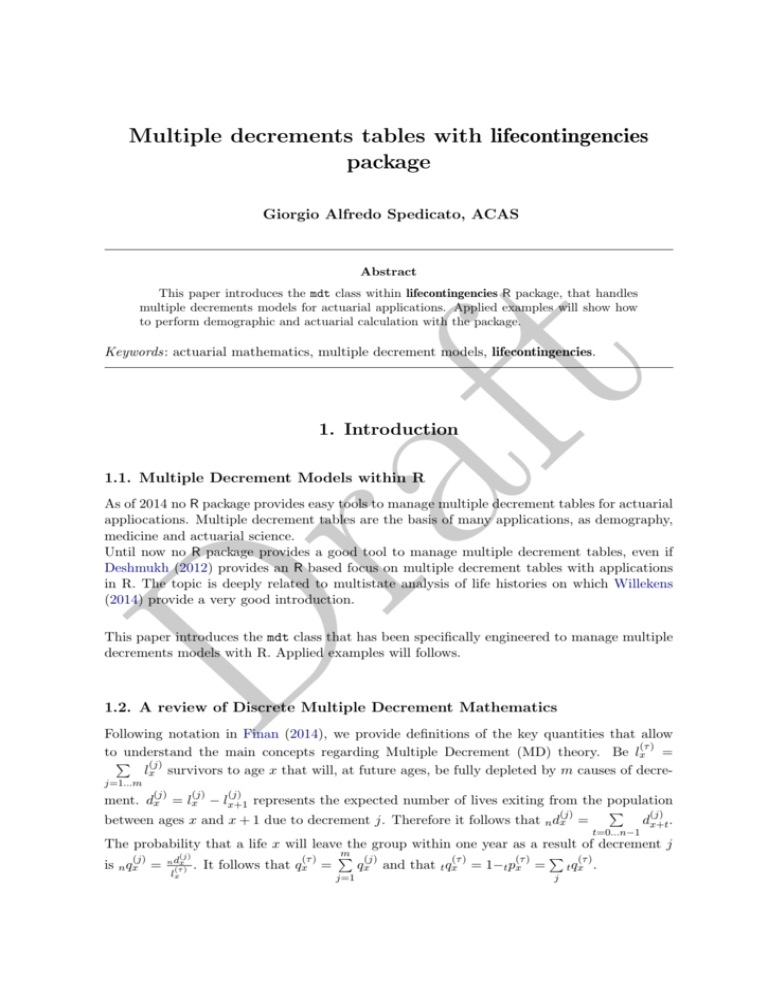
Multiple decrements tables with lifecontingencies package Giorgio Alfredo Spedicato, ACAS Abstract This paper introduces the mdt class within lifecontingencies R package, that handles multiple decrements models for actuarial applications. Applied examples will show how to perform demographic and actuarial calculation with the package. ft Keywords: actuarial mathematics, multiple decrement models, lifecontingencies. 1. Introduction Dr a 1.1. Multiple Decrement Models within R As of 2014 no R package provides easy tools to manage multiple decrement tables for actuarial appliocations. Multiple decrement tables are the basis of many applications, as demography, medicine and actuarial science. Until now no R package provides a good tool to manage multiple decrement tables, even if Deshmukh (2012) provides an R based focus on multiple decrement tables with applications in R. The topic is deeply related to multistate analysis of life histories on which Willekens (2014) provide a very good introduction. This paper introduces the mdt class that has been specifically engineered to manage multiple decrements models with R. Applied examples will follows. 1.2. A review of Discrete Multiple Decrement Mathematics Following notation in Finan (2014), we provide definitions of the key quantities that allow (τ ) to understand the main concepts regarding Multiple Decrement (MD) theory. Be lx = P (j) lx survivors to age x that will, at future ages, be fully depleted by m causes of decre- j=1...m (j) (j) (j) ment. dx = lx − lx+1 represents the expected number of lives exiting from the population P (j) (j) between ages x and x + 1 due to decrement j. Therefore it follows that n dx = dx+t . t=0...n−1 The probability that a life x will leave the group within one year as a result of decrement j m (j) P P (τ ) (j) (τ ) (j) (τ ) (τ ) is n qx = n d(τx) . It follows that qx = qx and that t qx = 1−t px = t qx . lx j=1 j 2 Multiple decrements tables 2. Multiple Decrement Models within lifecontingencies Package 2.1. The mdt class Examples in this paper are worked on slides provided in Valdez (2011). First of all, we load the R package. R> library(lifecontingencies) Then we create a mdt class object. We can use the first example found on (?, p. 4). ft R> valdezDf<-data.frame( + x=c(50:54), + lx=c(4832555,4821937,4810206,4797185,4782737), + hearth=c(5168, 5363, 5618, 5929, 6277), + accidents=c(1157, 1206, 1443, 1679,2152), + other=c(4293,5162,5960,6840,7631) + ) R> valdezMdt<-new("mdt",name="ValdezExample",table=valdezDf) Dr a Added fictional decrement below last x and completed x and lx until zero.... Completed the table at top, all decrements on first cause The mdt class is an S4 class object (Chambers 2008) comprised by a character slot name and a data.frame slot table that is composed by following columns: 1. x: the age, from 0 to ω. 2. lx: the subject living (at risk) at the beginning of age. 3. one or more colums for different causes of decrements. Values within table item represents absolute number of subjects at risk at the beginning of age x and dying for cause j during period x - x + 1. Within the various methods defined within the mdt class, setValidity performs consistency checks to properly create the mdt object. In particular, it verifies whether: 1. x and lx exist and that they are consistent. x should start from 0 and flows by increments of one. The first lx value should be equal to the sum of all decrements and that lx = lx−1 − (dx−1,1 + dx−1,2 + . . . + dx−1,k ) for any x. 2. If the decrements (or x and lx) have been provided only for partial ages, the table is completed below (from 0 to lx−1 ) assuming a decrement rate of 0.01 for the first cause of death. 3. if the decrements at last provided age, ω, do not sum to lω , the table is incremented by one row such as lxω+1 = lxω − (dω,1 + dω,2 + . . . + dω,j ). Giorgio Alfredo Spedicato, Gian Paolo Clemente 3 As shown, when the table is sanitized the operations performed are reported on logs. An internal function, .tableSanitizer tries to fix the limitations on the input table in order it to meet the class definition requirements. Table can be viewed thanks to a print and show method (output omitted for simplicity). Similarly, it is possible to export a mdt to a data.frame or to a markovchainList object (from markovchain package). R> print(valdezMdt) R> valdezDf<-as(valdezMdt,"data.frame") R> require(markovchain) R> valdezMarkovChainList<-as(valdezMdt,"markovchainList") R> getOmega(valdezMdt) Dr a [1] 55 ft Two specific methods have been defined for mdt class objects: getOmega, that returns the maximum attainable age (similar to the one of lifetable class), and getDecrements, that returns the decrements (by means of the names within table slot different from x and lx). R> getDecrements(valdezMdt) [1] "hearth" "accidents" "other" A summary method is available as well. R> summary(valdezMdt) This is Multiple Decrements Table: ValdezExample Omega age is: 55 Stored decrements are: hearth accidents other 2.2. Decrement probabilities calculation (j) (j) (τ ) The lifecontingencies package makes easy to compute dx , n dx as well as n dx thanks to dxt function. R> dxt(valdezMdt,x=51,decrement="other") [1] 5162 R> dxt(valdezMdt,x=51,t=2, decrement="other") [1] 11122 quantities 4 Multiple decrements tables R> dxt(valdezMdt,x=51) [1] 11731 Probabilities could be computed as well. R> dxt(valdezMdt,x=51,t=2, decrement="other") [1] 11122 R> pxt(valdezMdt,x=50,t=3) ft [1] 0.9926809 R> qxt(valdezMdt,x=53,t=2,decrement=1) [1] 0.002544409 Dr a It is possible to generate random traiectories of a life subject to multiple cause of decrements as the following code shows. R> rmdt(n = 2,object = valdezMdt,x = 50,t = 2) 1 2 50 "alive" "alive" 51 "alive" "alive" 52 "alive" "alive" 3. Actuarial Applications 1 )(1) The package now offers limited capabilities to fit multiple decrement insurances, e.g. (Ax:n The example in (Finan 2014, p. 674), cites: A 3-year term issued to (16) pays 20,000 at the end of year of death if death results from an accident. The mdt table is below created. R> myTable<-data.frame(x=c(16,17,18), + lx=c(20000,17600,14520), + da=c(1300,1870,2380), + doc=c(1100,1210,1331) + ) R> myMdt<-new("mdt",table=myTable,name="Sample") Added fictional decrement below last x and completed x and lx until zero.... Completed the table at top, all decrements on first cause Giorgio Alfredo Spedicato, Gian Paolo Clemente 5 1 )(a) is below calculated The value of (A16:3 R> Axn.mdt(object=myMdt,x=16,i=.1,decrement="da") [1] 0.1363636 References Chambers J (2008). Software for Data Analysis: Programming with R. Statistics and computing. Springer-Verlag. ISBN 9780387759357. ft Deshmukh S (2012). Multiple Decrement Models in Insurance: An Introduction Using R. SpringerLink : Bücher. Springer. ISBN 9788132206590. Finan MA (2014). “A Reading of the Theory of Life Contingency Models: A Preparation for Exam MLC.” http://faculty.atu.edu/mfinan/actuarieshall/MLCbook2.pdf. Accessed: 01/01/2015. Dr a Valdez E (2011). “Multiple Decrement Models: Math 3631 Actuarial Mathematics II.” http: //www.math.uconn.edu/~valdez/math3631s11/M3631Weeks7to8-S2011-annot.pdf. Accessed: 25/04/2014. Willekens F (2014). Multistate Analysis of Life Histories with R. Use R! Springer International Publishing. ISBN 9783319083834. URL https://books.google.it/books?id= Cd2CBAAAQBAJ. Affiliation: Giorgio Alfredo Spedicato Ph.D ACAS C.STAT Via Firenze 11 20037 Italy E-mail: spedygiorgio@gmail.com URL: https://github.com/spedygiorgio/lifecontingencies
